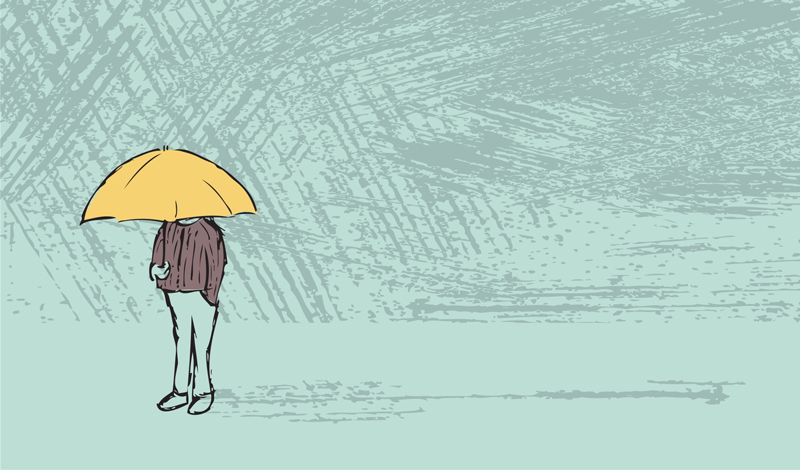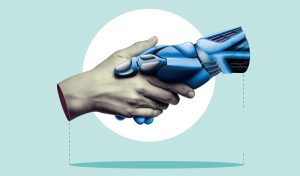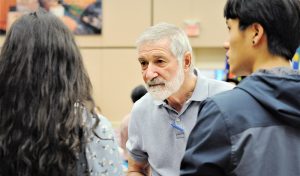Two-and-a-half millennia ago, the Greek philosopher Aristotle wrote that human beings by nature are social animals: “Anyone who either cannot lead the common life or is so self-sufficient as not to need to, and therefore does not partake of society, is either a beast or a god.”[1]
And yet here we are, in an age when we can enjoy every modern convenience without physically interacting with another human being. We can earn an income, buy groceries, launder our clothes, see a doctor and stream a movie without ever stepping foot outside the home.
But even the ever-growing convenience of virtual platforms has its limitations. The rise in loneliness among people of all ages and backgrounds has generated serious consequences that threaten our happiness, health and even social stability. In a 2021 survey studying loneliness in men, 15% said they have no close friends, a sharp increase from the 3% reported in 1995.[2] Studies also show that people who experience loneliness have a higher risk of heart disease, stroke and dementia[3]—not to mention its toll on mental health.
As community ties fray, so do mutual support as well as cooperation during natural disasters. Our lack of connection has also contributed to a widening political divide that has led to demonizing those of differing views. It’s no surprise, then, that in May 2023, the U.S. surgeon general released an 85-page advisory declaring loneliness a new public health epidemic in our country.
The advisory explains loneliness to be a subjective, distressing experience resulting from perceived isolation or inadequate meaningful connections.[4] As Buddhists, we aim to do the opposite: to treasure the people in our lives and provide them with meaningful connections.
Nichiren Daishonin explains:
“Joy” [in the phrase “responding with joy”] means that oneself and others together experience joy. … Then both oneself and others together will take joy in their possession of wisdom and compassion. Now, when Nichiren and his followers chant Nam-myoho-renge-kyo, they are expressing joy in the fact that they will inevitably become Buddhas eternally endowed with the three bodies[5].[6]
Buddhahood, in other words, cannot be experienced in isolation but rather this state of life is developed through our interaction with others.
As we strive to create lives of fulfillment and polish our humanity, let us consider three concrete challenges we can adopt toward creating families and communities forged by deep human ties.
Challenge One: Increase meaningful relationships.
The average Facebook user has 338 friends. The problem, though, isn’t the number of our relationships but the quality of our connections.
Our first challenge is to get better at knowing others. Buddhism teaches that each individual is a microcosm of the universe who holds vast riches of unique experiences, feelings and wisdom. When we actively seek to know more about those around us, we can develop meaningful relationships that strengthen our social fabric.
Ikeda Sensei writes: “The better you know others, the easier it is to converse with them. That’s why you must make a serious effort to get to know people. When you’ve done that, just converse sincerely with them in the way that comes naturally to you.”[7]
In the same vein, he defines dialogue as “the courageous willingness to know and be known by others. It is the painstaking and persistent effort to remove all obstacles that obscure our common humanity.”[8]
What are the person’s hobbies and interests? What is their family history? What are they struggling with now? Through engaging in the process to know another, not only can we change our assumptions about others but also develop authentic friendships.
Not everyone is so quick to open up to others, so it’s vital that we find the courage to be the one who can sincerely engage others, being willing to have honest conversations. The Daishonin says of this: “Even a stranger, if you open up your heart to him, may be willing to lay down his life for you.”[9] Developing such quality connection is vital to enriching our lives.
While there’s nothing wrong with connecting to a vast amount of people through social media, such networks alone do not satisfy our need for human interaction. And in creating meaningful relationships, we don’t have to be extroverts either. What is important is that we endeavor to develop the types of friendships where we can fully open our hearts. Sensei explains the Buddha’s thoughts on friendship:
When Shakyamuni’s disciple Ananda asks whether advancing together with good friends is half the Buddha way, Shakyamuni replies: “Ananda, this way of thinking is not correct. Having good friends and advancing together with them is not half the Buddha way but all the Buddha way.”[10]
How can we forge such bonds with others? It comes down to treasuring the person in front of us. When a member asked Sensei how he was able to do so, he replied:
There’s no secret to it at all. … I just give each encounter my all. I know that I may never see the person again, so I think about how I can connect deeply with them and pour my whole being into doing so. That earnest commitment manifests itself as wisdom and strength.[11]
When we act to emulate this spirit, we can take a step in forward in connecting more deeply with others and finding our footing where we are.
Challenge Two: Deepen bonds with friends in our Soka community.
Our SGI Buddhist community is distinct in that it provides a network where we bond over our shared commitment to spread the Buddhist ideals of equality, respect, peace and harmony. In short, we fight alongside one another to realize the greater good of kosen-rufu. By cultivating these bonds, rooted in propagating the Mystic Law, we form unbreakable ties that help us transcend our personal likes and dislikes, and transform our lives for the better.
Second Soka Gakkai President Josei Toda described our united efforts, saying:
When it comes to the matter of drinking this sake, you will instantly agree with each other and join in beautiful unity. That’s unity centered on a bottle of liquor. Again, suppose there is a large, delicious-looking cake. You’ll immediately and joyfully become unified in one mind: to eat it. But the sake or the cake will be quickly gone and with it your unity. …
Nothing can be achieved unless we carry out our activities with the realization that the Gohonzon is reverently positioned in the center of any activity, under any and all circumstances. Only when we engage in our activities with that realization can there be unity based on faith. Those in responsible positions must not forget this at any time or under any circumstance. True, liquor or cakes can bring about temporary unity, but when they are consumed that’s the end of their mission. On the other hand, the Gohonzon eternally entails the mission for kosen-rufu—the mission to dispel all kinds of misery from this earth.[12]
SGI discussion meetings provide opportunities to connect in our local communities with people who hail from all walks of life and yet share the same goal to create a world in which all people can lead happy and secure lives.
In discussing the depersonalization of society, Sensei writes that it’s difficult to develop ourselves fully without laying down roots:
Families knew their neighbors, and people freely borrowed from each other when the bean paste or soy sauce had run out and it was inconvenient to go shopping. The flood of urbanization and great modern mobility bring people together from all over the nation, to live for a period in homes and apartments that are virtually no more than places to sleep, and then perhaps to move on to another city or neighborhood where they are as much strangers as ever.
In other words, people today do not take root in any one place long enough to develop themselves as total persons. They perform as cogs in the wheel on the job and return at night to houses, not homes. It is difficult to estimate the depth of mental insecurity and irritation that life without community contacts engenders.[13]
Our united network of Bodhisattvas of the Earth is the impetus for creating communities based on deep-rooted human connections.
Week after week, month after month, SGI members gather to chant Nam-myoho-renge-kyo, study Buddhist concepts that elevate our lives and share personal stories, including victories and ongoing struggles, encouraging one another to continue fighting for our dreams and happiness. Sensei describes our wonderful Soka movement as a place to actualize lasting peace and happiness based on the principle of human revolution:
The realm of kosen-rufu is one of bright, lively dialogue and inspiring life-to-life encounters. It is pervaded by an enthusiastic spirit of good citizenship to create a better society. It is a community of human harmony spanning the globe, in which people of diverse cultural backgrounds come together as one big family, sharing each other’s joys and sufferings.[14]
Our Soka community provides a space for people of all backgrounds to come together, learn from one another’s experiences and make a shared determination to widely disseminate the Mystic Law in our communities to expand this network of heartfelt connections.
Challenge Three: Strengthen our personal connection to the Mystic Law and the mentors of Soka.
There are times when, despite our best efforts to connect with others or have others connect to us, we still feel lonely. That might be because we’re facing a difficulty that we believe no one can understand or we’re gripped with fear that in honestly sharing our struggles, we might lose the trust or respect of those around us.
Even amid such times, we can chant Nam-myoho-renge-kyo and tap the limitless wisdom, courage and compassion of the universe. In addition, by uniting our hearts with our mentor in faith, we can awaken to our unique mission to advance kosen-rufu; being filled with such purpose can help us dispel any feelings of loneliness and isolation.
After Nichiren Daishonin was exiled to Sado Island in 1271, many of his disciples abandoned their faith to the extent that “999 out of 1,000 people” in Kamakura no longer chanted. At age 49, he was sent alone to die on a remote island, describing his time in exile in this way:
In the yard around the hut the snow piled deeper and deeper. No one came to see me; my only visitor was the piercing wind. Great Concentration and Insight and the Lotus Sutra lay open before my eyes, and Nam-myoho-renge-kyo flowed from my lips. My evenings passed in discourse to the moon and stars on the fallacies of the various schools and the profound meaning of the Lotus Sutra. Thus, one year gave way to the next.[15]
Based on his towering life condition, even the snow, piercing wind, and moon and stars served as companions for Nichiren as he initiated the next stage of kosen-rufu from Sado Island.
Sensei, too, recollects his solitary battle amid a barrage of slander from the Nichiren Shoshu priesthood in the late 1970s. He writes in The New Human Revolution about the importance of seeking his mentor, Josei Toda, in his heart. Sensei, who appears in the novel as Shin’ichi Yamamoto, describes his thoughts during Mr. Toda’s April 1979 memorial:
As he chanted for his mentor during the memorial service, Shin’ichi envisioned Toda gazing at him. He could hear his mentor say: “Shin’ichi, I’m counting on you to achieve worldwide kosen-rufu! Have no fear! Boldly pursue the great path of your mission!”
Courage rose in his heart. He felt a surge of strength course through his being.
“I am Mr. Toda’s disciple! I am the heir of this heroic lion king who stood up alone for kosen-rufu! Whatever may happen, I will faithfully transmit Nichiren Buddhism and the Soka Gakkai spirit! I will fight to protect the members, the noble children of the Buddha!”[16]
At the time, Sensei stood up alone. With his mentor in his heart, he was emboldened to continue striving for kosen-rufu despite being backed into a corner.
In the same spirit as Nichiren and Sensei, SGI members are also “heroic lion kings” who are guaranteed profound personal victory when they strive to advance kosen-rufu without giving in, no matter the situation.
When we chant Nam-myoho-renge-kyo powerfully to the Gohonzon and unite our hearts with our mentor, we can dispel any feelings of loneliness and boldly advance toward our dreams, amid even the most painful trials.
We have one another.
Social isolation and loneliness can be debilitating. In a world where existential threats loom, the way we connect and feel connected to others is up to us. Ultimately, it comes down to not ideology or abstract ideals but heart-to-heart connections that buoy human society in difficult times.
This starts with each of us taking on these three challenges: to deepen connections in our environment, treasure our Soka community and strengthen our bond with the Mystic Law and our mentor. These may seem like common sense but actualizing them is a nearly lost art. As the level of genuine interest in others becomes increasingly rare, our friends who notice this unique quality in us will naturally want to learn more about our Buddhist philosophy.
Consider this story shared by Russian author Leo Tolstoy, in which an emperor wonders about three questions:
1) When is the best time to start a task, to know the right time for every action, so that I have no regrets?
2) What kind of person do I need most and to whom I should pay attention to?
3) What affairs or tasks are the most important?
The emperor makes it known throughout the land that he will richly reward anyone who can tell him the right answers to these questions. In the end, the emperor gains the answers from a sage who lives among the people. Sensei writes of this exchange:
This wise man replies that the most important time is now, this very moment; the most important person is the one in front of you right now; and the most important task is doing good to others, caring about others’ happiness.
This moment, this instant is important, not some unknown time in the future. Today, this very day, is what matters. We must put our entire beings into the present—for future victory is contained in this moment.
Likewise, we do not need to look for special people in some far-off place. People are not made important simply by virtue of their power, learning, fame or riches. The most important people are those in our immediate environment right now.[17]
Wherever we are, we can practice the “lost art” of sincerely greeting and connecting with the people in front of us. We can endeavor to consider the unique characteristics of those around us and make it possible for them to bring forth their full potential. This is the way to win the trust and respect of everyone around us. This is where friendship starts and loneliness ends.
From the August 2023 Living Buddhism
References
- The Politics, Aristotle, Book I. ↩︎
- https://www.sciencefocus.com/science/how-loneliness-is-killing-men/ ↩︎
- https://www.hhs.gov/about/news/2023/05/03/new-surgeon-general-advisory-raisesalarm-about-devastating-impact-epidemicloneliness-isolation-united-states.html ↩︎
- https://www.everydayhealth.com/loneliness/ ↩︎
- The three bodies are as follows: 1) The Dharma body, or body of the Law. This is the fundamental truth to which a Buddha is enlightened. 2) The reward body, obtained as the reward of completing bodhisattva practices and acquiring the Buddha wisdom. 3) The manifested body, or the physical form that a Buddha assumes in this world in order to save the people. ↩︎
- The Record of the Orally Transmitted Teachings, p. 146. ↩︎
- June 16, 2023, World Tribune, p. 8. ↩︎
- September 28, 2007, World Tribune, p. 2. ↩︎
- “On Rebuking Slander of the Law,” The Writings of Nichiren Daishonin, vol. 1, p. 444. ↩︎
- April 2017 Living Buddhism, p. 57. ↩︎
- The New Human Revolution, vol. 20, p. 109. ↩︎
- The Human Revolution, pp. 1335–36. ↩︎
- Human Values in a Changing World, p. 76. ↩︎
- January 1, 2007, World Tribune, p. 2. ↩︎
- “The Actions of the Votary of the Lotus Sutra,” WND-1, 770–71. ↩︎
- NHR-30, 16. ↩︎
- The Wisdom for Creating Happiness and Peace, part 1, revised edition, pp. 235–36. ↩︎
You are reading {{ meterCount }} of {{ meterMax }} free premium articles





